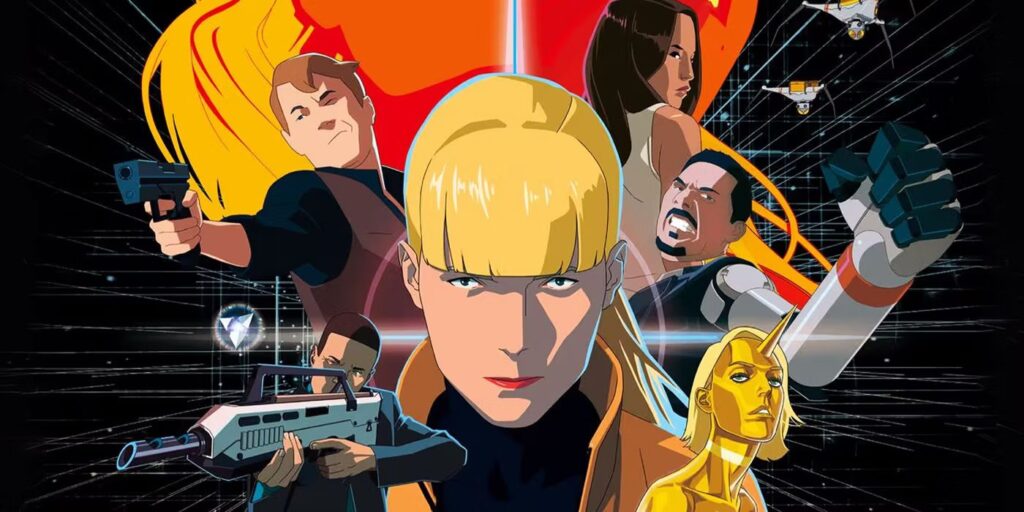Mars Express is an ambitious sci-fi animated film from director Jérémie Périn. Set in the 23rd Century on Mars, investigator Aline Ruby and her android companion Carlos Rivera are solving a murder case that will lead them to an event that will change the world.
The animated film is geared toward adults as it deals with mature themes and features a world where humans and androids coexist. Androids are seen as inferior and are treated like second-class citizens, but there is hope for them as there is a code that will help free them.
We had the chance to chat with Périn about the film, his inspirations, and more.
Nerd Reactor: What was the process like, ‘I want to do this movie next; this movie about this investigator in the world of Mars?’
Jérémie Périn: Well, there are many, many factors and ideas coming in at the same time and merging all together for that movie. I’m a huge fan of sci-fi. So years ago, way before I started to work on that movie, I really wanted to do a sci-fi movie. You know, sci-fi is a jar, but inside that jar, there were a lot of possibilities. You can do fantasy sci-fi. You can do post-apocalyptic stories. There were a lot of possibilities and it appealed to me and Laurent Sarfati, my co-writer. Something was missing when we began to think about the movie, and it was more of an odd science aspect of sci-fi kind of story.
What I mean by that is science fiction in a more tangible way, something more realistic. At the time, it was this moment when tech billionaires were talking about living in space in a space station including Jeff Bezos and Elon Musk. We were not convinced with such projects coming from them, especially from them. We were like, ‘Okay, what kind of society could it be with them in space, and in a way, we were also critical because, for us, they are representing the side of the human species that is responsible for the climatic change of today, you know, they are involved in this capitalistic way of ruling the world and not thinking about the repercussions of the pollution and stuff like that.
So we thought we should maybe work on that and the idea of what could it be. What kind of world it could be. A small part of humanity would live on a different planet, and the closest one and the more probable one was Mars. So we tried that. And also at the same time, I thought what we’re missing in the landscape of movies and the kind of story we had at the time in cinema was the private eye kind of story. Investigation stories such as Chinatown or The Long Goodbye, with private investigators walking around the Old City and knowing everything and everybody from the outcasts to the higher society and stuff like that. So we wanted to mix everything together. And then we started to find the story there.

I think I saw some influences from Ghost in the Shell. Maybe. I don’t know if that’s your intent in that one. Cyberpunk genre like Blade Runner, are those influences too? And how do you try to incorporate things that you love into this movie?
Jérémie Périn: In fact, yeah. I guess Ghost in the Shell and Blade Runner have these in common, and Mars Express, of course, is a mix of sci-fi and investigation. In both cases, I remember when Ghost in the Shell came out, everybody said it’s like Blade Runner in animation. And now, for Mars Express, a lot of journalists and even the audience are talking about like what you’re doing about Blade Runner and Ghost in the Shell. And it’s true.
I mean, those two movies, the joke is that I don’t really like Blade Runner, but I really like Ghost in the Shell, and my co-writer, it’s the contrary. He doesn’t really like Ghost in the Shell, but he loves Blade Runner. So we didn’t try to exactly quote those movies, but it would be lying to say no, there is no relationship between Mars Express and those movies. Of course, there is. Mostly we got our inspiration not so much on sci-fi, but more on the film noir aspect of the movie. And we watched a lot of old P.I. movies and stuff like that. Not so much sci-fi movies because it’s in our blood already. We didn’t feel that we had to work on that.
But yeah, I guess there are some influences, of course, that’s for sure. But not every time. You know, there are some quotes. And also, there are some accidents. It’s not exactly an accident, but unconsciously you are repeating something you already saw. And sometimes what surprised me the most is that some spectators played the game of getting the quotes, like, it is a reference to this. This is a reference. And sometimes I was like, ‘Yeah, of course.’ And sometimes I’m like, ‘No, no, I see why you’re saying that. But it’s not exactly on purpose.’ And in the end, I don’t really enjoy the fact that people play that game, even if, of course, the movie is full of a lot of influences. And the ones you pointed out are indeed true.
I want to talk about the animation because I believe it’s a blend of 2D and 3D, right?
Jérémie Périn: Yeah, it was on purpose. First, I really wanted to try to work more with 3D animation, and I thought the subject was nice to try to work on that. And it came really quickly that I would split the 3d and the 2d animation thematically. And just to summarize quickly, humans are hand drawn in 2D by humans, and my idea was that robots are in 3D, because they are rendered by machines. It’s like two sides of the production would be split in half. Machines would render machines and humans would render humans. And all of that are mixed together.
It’s not that simple. In fact, in the end, it’s like, what is in 3D is more precisely, characters that think there are humans or machines. For instance, Carlos in the beginning of the movie, thinks he is a human. So during the long part of the movie, he is hand-drawn. Because what is important is how he sees himself. But at the end of the movie, only his head is hand-drawn and his body is in 3d. So to me, it is expressed in a subtle way. It’s a way to say that he’s doubting his old nature. He’s in between, and he’s like, “What am I?” It’s an existential question, illustrated with the technique we used for the whole movie.
The interview has been edited for length and clarity.







